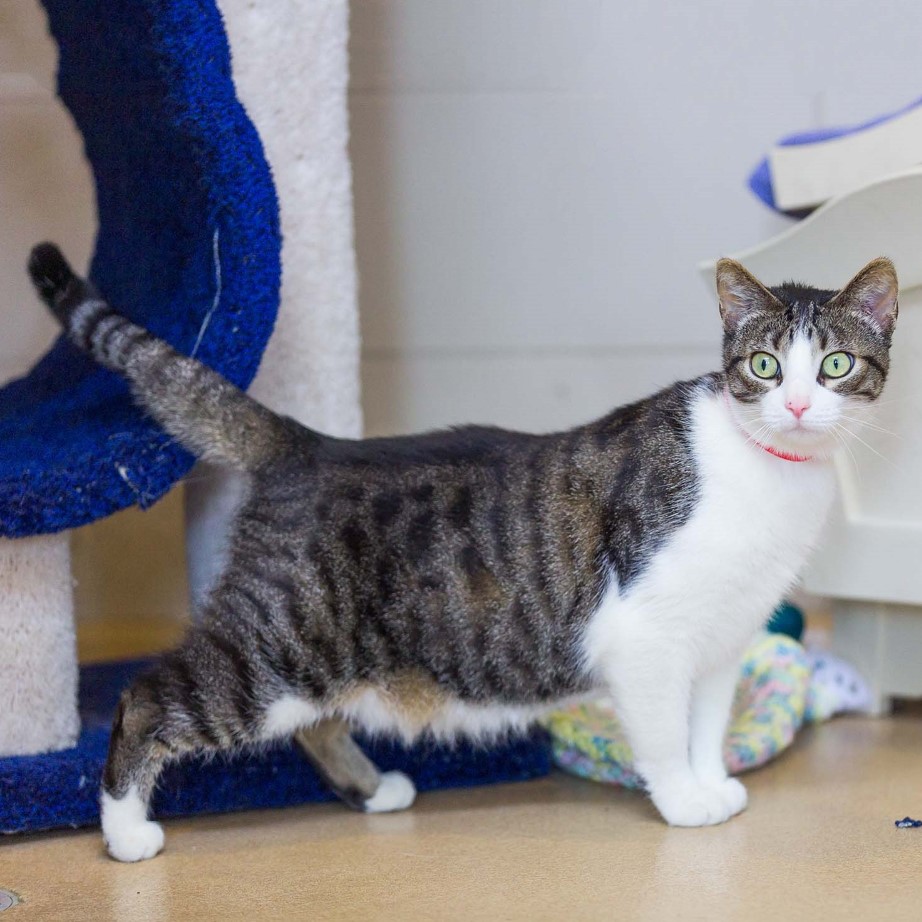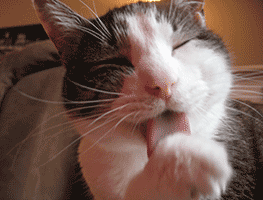Cat Spraying/Marking
 Is your cat spraying on or marking your furniture with their urine? While cats may pee outside the litterbox for many different reasons, urine marking is very specific – they’ll still use their litterbox as normal, but will also spray urine onto vertical surfaces or leave small amounts in intentional spots in an effort to mark their territory. It’s rare, but some cats will also mark with feces. This is a natural, instinctive behavior and a means of communication for cats, but it’s certainly not fun for us humans. Cats also have scent glands in their paws and cheeks, which is partly why they like to claw things and rub their chins onto objects (or people!).
Is your cat spraying on or marking your furniture with their urine? While cats may pee outside the litterbox for many different reasons, urine marking is very specific – they’ll still use their litterbox as normal, but will also spray urine onto vertical surfaces or leave small amounts in intentional spots in an effort to mark their territory. It’s rare, but some cats will also mark with feces. This is a natural, instinctive behavior and a means of communication for cats, but it’s certainly not fun for us humans. Cats also have scent glands in their paws and cheeks, which is partly why they like to claw things and rub their chins onto objects (or people!).
Causes of urine marking can include the following:
- Your cat hasn’t been spayed/neutered.
- There have been changes in your cat’s routine or daily life (moving, adding furniture, bringing home a new animal, adding another human to the home, etc.).
- Another cat’s scent has been introduced to the home via second-hand objects.
- There has been conflict or tension with other animals in the home.
- Your cat sees outdoor cats near your home through the window.
- Your cat has contact with other animals while outside the home.
Solutions for urine marking
Unaltered cats | If your cat is not altered, seek out spay/neuter services. Both male and female cats are more likely to urine mark if they are unaltered, and the longer the cat practices this behavior, the harder it is to change. You can find low-cost spay/neuter services near you by visiting www.wihumane.org/spay-neuter or by contacting your veterinarian. In many cases, this will solve the problem without additional management.
Changes to the home | Changes that occur in your home can trigger your cat to begin urine marking. Whether it’s a remodeling project, the arrival of a new baby, or even some new furniture, change can be challenging and stressful for cats. If urine marking occurs after changes in your home, look for ways to decrease your cat’s stress and help your cat create a positive association with the change or new thing. This could include offering your cat yummy treats or canned food in the presence of the new item or person. If you remodeled a room or changed furniture, begin play sessions with your cat in that room or give them treat-dispensing enrichment toys in that space. This will not only create a positive association with the cat and the new room, but the cat will be less likely to mark in the same area they now see as a location for eating or playing.
For cats who are uncomfortable with the change, it may be helpful to isolate them to one room or part of the home to allow them to decompress. After several days – and when their behavior in the smaller space is back to normal – slowly reintroduce your cat to the rest of the home. Even if your cat was not typically fearful prior to this change, our resource on Fearful Cats is a good roadmap for helping your feline friend feel more comfortable and decrease their urge to mark.
Second-hand objects | In an effort to be more eco-conscious, many families are sourcing things like clothing, furniture, bedding, and outwear from thrift shops, social media groups, or as hand-me-downs from other households. But even items that look and smell clean to us can be carrying scents that are easily detectable to your cat. For example, you may have been given a baby blanket from a fellow parent and have started using it around the house for your child, not realizing it’s carrying the scent of the previous family’s cat. Now your own cat may be on edge and feel like their territory is being encroached upon by an unwanted (and unseen) visitor, causing them to start marking. As a practice, get in the habit of immediately laundering or thoroughly cleaning any washable items that come to you second-hand.
Conflict between animals | Marking is a territorial behavior. If there is tension or conflict between your cat and other animals in the home, your cat may feel threatened and start to mark their territory. If the marking started when you added a new pet to the family, your cat is likely feeling stress or tension regarding the newcomer. Alleviating this tension could be as easy as increasing resources in the home by providing additional food bowls, water bowls, litter boxes, vertical space, and toys. But if the behavior continues, please reference our resources on Aggression Between Cats and Cat-to-Cat or Cat-to-Dog Introductions for more guidance on setting two animals up for a successful life together.
Outside visitors | If there are cats wandering your neighborhood and visiting your yard, your own cats may feel the need to mark their territory by spraying near doors and windows. Although it is impossible to completely stop other cats from using your yard as a thoroughfare, you can modify your home to decrease your cat’s view of the passersby. Try blocking their sightlines by covering the bottom half of your windows and glass doors with privacy film, cardboard, or even a few strategically propped pillows. Take into account your cat’s favorite nature-viewing spots in the home. For example, if they have a cat-climber that looks out towards your front yard, consider moving it to a rear window where your yard is fenced and less likely to have unwanted visitors in sight.
Interacting with cats while outside the home | Cats who spend some of their time roaming freely outside have an entire life their owners know nothing about. If they encounter other cats or animals that they do not get along with, it can increase their desire to mark their territory when they’re back home. This is one of the many reasons we recommend keeping cats indoors. By keeping them inside, you reduce the risk of your cat getting into an altercation with another animal, along with many other potentially harmful threats. If you are transitioning your cat from indoor/outdoor to indoor only, read our resource on Cat Enrichment for ways to provide your cat with plenty of mental and physical enrichment each day.
Tips and things to consider:
- Clean previously marked areas with enzymatic cleaner. If your cat can smell that they have previously marked an area/object, they are likely to continue marking that location.
- If you have multiple cats in your home and aren’t sure who is marking, you can ask your vet for fluorescein dye to identify the culprit and help set them up for success.
- While determining the trigger for your cat’s behavior, block off the areas they have been marking. For example, close doors or put up gates to block access to a piece of furniture your cat has been marking.
- Cats generally don’t spend social time where they urinate/defecate, including the areas they mark. You can help your cat view their previous marking zone as a positive place by playing with them, giving treats, petting, or feeding them in that location, thus making it a less desirable spot to eliminate in.

